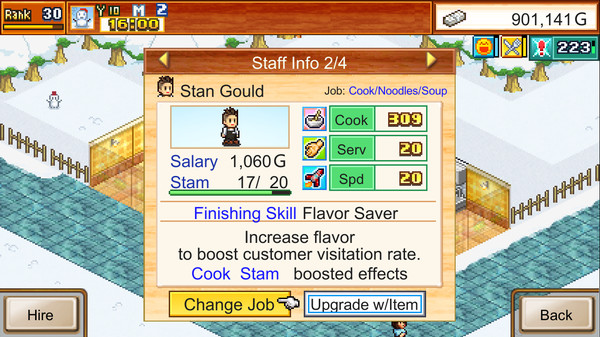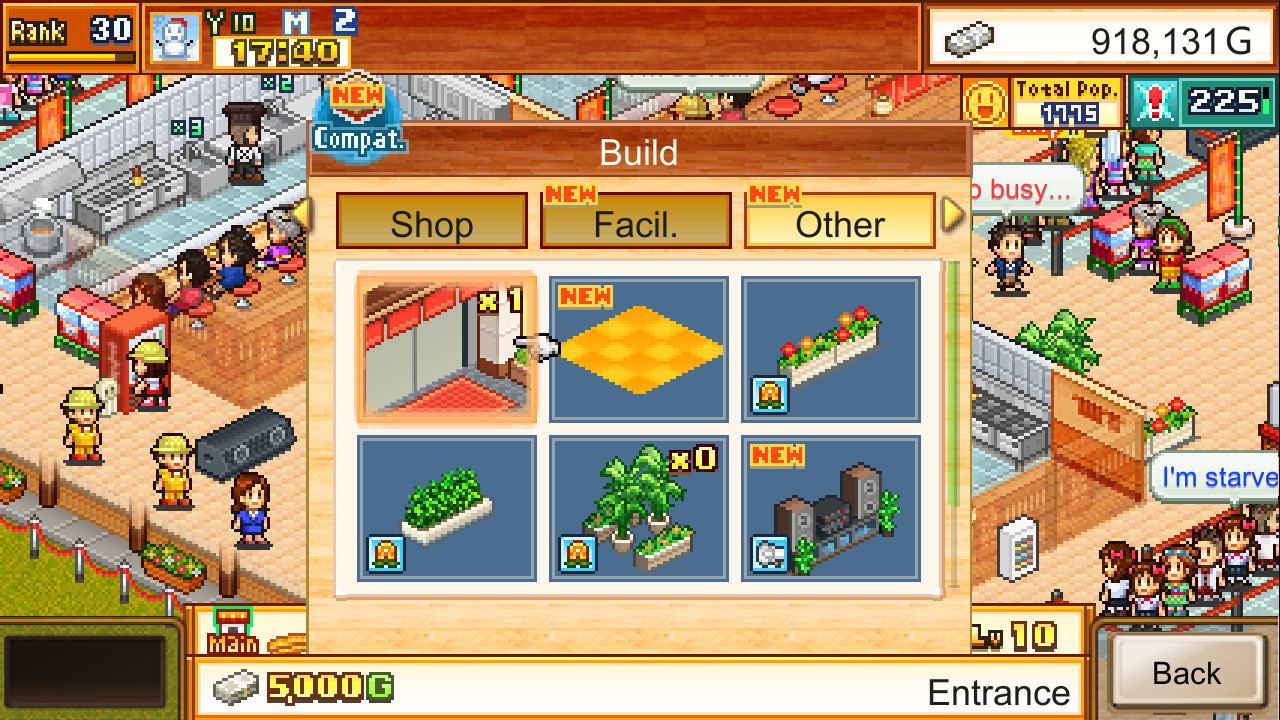Have you tried… ascending to Noodle God in The Ramen Sensei?
Slinging noodles is a lot more complex than you might think

Back in college I considered myself a master chef when I added a hard-boiled egg to my instant noodles, but now, as I'm playing The Ramen Sensei, I realize I'm a lot more like Brittany Murphy at the beginning of the 2008 movie Ramen Girl: a lowly student at the start of his path toward noodle mastery. With hungry townsfolk lining up outside my ramen shop, I debate whether the "peerless" combo boost gained by combining nori (seaweed) and chashu (thin-roasted pork) is worth the hit to my shoyu ramen's affordability. Notoriously budget-minded students and poets are some of my most frequent customers, but if I don't boost the dish's appeal I might have to scrap it and start on a brand new creation.
Oh, and what went wrong with my shio ramen with extra negi? That's my go-to order at a noodle joint, but I haven't sold a bowl all day. Meanwhile, the ramen creation I haphazardly threw together when I first started the game remains my best seller. It's a downright culinary science figuring out how to sell more ramen in this game, and it makes me wonder if my dream of retiring in rural Japan and opening a noodle shop would really be the quiet, uncomplicated vibe I want for my twilight years. However, as a cute little indie game I can play in-between slurps of takeout noodles, it's great fun.
Let me shoyu the basics

It genuinely took me a good chunk of time to grasp the basics of The Ramen Sensei, I should note upfront. The UI is a pixelated assault on the senses that uses red exclamation points to draw your attention to its many menus, icons, and stats, but clicking where I'm told to doesn't result in further instruction. Meanwhile, the barebones tutorial does little to clarify what exactly is happening, which makes the first hour or so a little overwhelming. I will also freely admit that there are some things I still don't understand about this game - how to make a dish less difficult to make without sacrificing its flavor and appeal, for one - and even so, I am very much enjoying my time with it.
At $9, The Ramen Sensei doesn't skimp on the toppings. Early on, there isn't a whole lot of ramen customization, but as you sell more and more bowls you'll unlock a myriad of authentic broth, noodle, and topping combinations. Though, as I alluded to earlier, it's not all about making your ideal bowl of ramen - after all, you're not the customer. While I might prefer a nice golden-yellow shio broth with a perfectly charred slice of chashu, a slightly runny onsen egg, and plenty of negi, my customers at Sunny Ramen have all sorts of different tastes.
For example, the student that tends to visit my shop after class naturally has a tighter budget than the businessman who stops in on his lunch break. Meanwhile, the office clerk likes healthy noodles, so I need to make sure I have a menu option that works with her dietary restrictions. Customers also eat at different speeds and have varying levels of patience for long lines, and that'll naturally affect your restaurant's table turnover.
Oodles of noodle options

There's a dizzying array of figures to manage in your quest to become Ramen God of Sunnyville, and then of Busy Burg, Hot Seaside, Ice Mountain, Hideout Street, Gorgeous City, and Kairo Street. First you'll want to build out your staff, who have stats for cooking, speed, service, and stamina, as well as unique finishing skills, like… "flavor saver." Moving on, you can also change your employees' jobs at any point and upgrade their skills, but be mindful of burnout: if you don't have a chair for each ramen apprentice to rest, they'll eventually grow tired of your bullshit and refuse to work for a while.
Your noodles will be ranked by flavor, appeal, richness, aroma, volume, and charisma, all of which affects your sales. Keeping all that in mind, you'll then start crafting bowls of noodles, which is supremely satisfying even if you don't entirely know what you're doing. You get to choose and eventually customize your broth from a bunch of traditional Japanese recipes, arrange a huge variety of toppings to your exact aesthetic liking, and experiment with a great deal of combos that grant bonuses.
Sign up to the GamesRadar+ Newsletter
Weekly digests, tales from the communities you love, and more

Once you're happy with your staff and menu options, you can sit back and enjoy the fruits of your entrepreneurial efforts, as hungry customers line up to be served your meticulously crafted noodle bowls. After each new creation there's a taste test that'll tell you where you might want to tweak your ramen to better suit your customers' preferences, but after that you'll get a nice view of your thriving business as crowds of customers come and go. Particularly satisfied patrons who reach peak fullness will give you Spirit Points, which you can use at the item shop for employee, customer, and ramen stat boosts, as well as decorations for your shop.
There's also your business's profits, ingredients, labor costs, and upkeep costs, equipment, and decorations you have to manage. Your regulars will occasionally let you invest in things like the Clean Park initiative, vending machines, benches, tea rooms, fliers, billboards, ATMs, and loads more, all with the goal of boosting your ramen shop's appeal, of course. As you go you'll continue hiring new staff, training existing employees, learning new customer preferences, buying ingredients, upgrading your equipment, expanding your shop, investing in stuff, and generally growing your ramen empire.

I haven't even mentioned the arena. Oh, the arena. If you weren't satisfied with this already surprisingly robust management sim, there's also a whole separate thing where you battle with other ramen shops for the championship. I'm only just now learning the mechanics of the arena, but I've managed to essentially button-mash my way to a number of victories. If you're keen on progressing through the game as quickly as possible, you'll want to put your best ramen forward in the arena, as if you do well you could rank up and boost your max Spirit Points.
Not shio simple

While I thoroughly enjoy the constant dopamine hits from learning the systems and seeing how it benefits my sales, my favorite part of The Ramen Sensei requires only a surface level understanding of the game's complex meta. More than anything I just like to play around in ramen creation, testing out new ingredients and tinkering with recipes. It's an aesthetic thing for sure; I've always been a sucker for SNES-style graphics, and anything with Japanese food is an instant win with me; but it's also rewarding to curate a menu that's as pleasing to the eyes as it is to my customers.
Of all of the systems in the game, this one's the simplest. The customers will tell you plainly what they like and don't like about a particular dish, and it's up to you to go in and adjust your recipes to their liking. Finding that perfect balance between affordability and appeal, presentation and practicality, is where it's at.
For less than a bowl of ramen, you can pretty much ignore everything else about the game and just focus on making noodles and you'll still be getting your money's worth. That said, if you enjoy strategizing, there's plenty of depth to the city-builder aspects of the game as well. If nothing else, it'll give you some ideas for spicing up your Cup Noodle game.
The Ramen Sensei is out now on PC via Steam, Android, iOS, and PS4.
After scoring a degree in English from ASU, I worked as a copy editor while freelancing for places like SFX Magazine, Screen Rant, Game Revolution, and MMORPG on the side. Now, as GamesRadar's west coast Staff Writer, I'm responsible for managing the site's western regional executive branch, AKA my apartment, and writing about whatever horror game I'm too afraid to finish.



